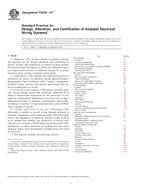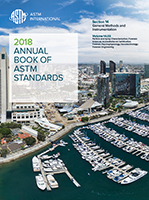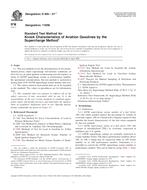
ASTM F2639-07e1
1.1 Definition – This practice defines acceptable practices and processes for the design, alteration, and certification of electric systems and installations in general aviation aircraft. This practice does not change or create any additional regulatory requirements nor does it authorize changes in or permit deviations from existing regulatory requirements.
1.2 Applicability – The guidance provided in this practice is directed to air carriers, air operators, design approval holders, Supplemental Type Certificate (STC) holders, maintenance providers, repair stations, and anyone performing field approval modifications or repairs.
1.3 Protections and Cautions – This practice provides guidance for developing actions and cautionary statements to be added to maintenance instructions for the protection of wire and wire configurations. Maintenance personnel will use these enhanced procedures to minimize contamination and accidental damage to electrical wiring interconnection system (EWIS) while working on aircraft.
1.4 “Protect and Clean As You Go“ Philosophy – This philosophy is applied to aircraft wiring through inclusion in operators' maintenance and training programs. This philosophy stresses the importance of protective measures when working on or around wire bundles and connectors. It stresses how important it is to protect EWIS during structural repairs, STC installations, or other alterations by making sure that metal shavings, debris, and contamination resulting from such work are removed.
1.5 This practice includes the following sections:
| Title | Section |
| Wire Selection | 5 |
| General | 5.1 |
| Aircraft Wire Materials | 5.2 |
| Table of Acceptable Wires | 5.3 |
| Severe Wind and Moisture Problems (SWAMP) | 5.4 |
| Grounding and Bonding | 5.5 |
| Electrical Wire Chart | 5.6 |
| Wire and Cable Identification | 6 |
| General | 6.1 |
| Wire and Cable Identification | 6.2 |
| Types of Markings | 6.3 |
| Sleeve and Cable Marker Selection | 6.4 |
| Placement of Identification Markings | 6.5 |
| Wiring Installation | 7 |
| General | 7.1 |
| Wire Harness Installation | 7.2 |
| Power Feeders | 7.3 |
| Service Loops | 7.4 |
| Drip Loops | 7.5 |
| Soldering | 7.6 |
| Strain Relief | 7.7 |
| Grounding and Bonding | 7.8 |
| Splicing | 7.9 |
| Fuel Tank Wiring | 7.10 |
| Corrosion Preventative Compounds (CPC) (MIL-C-81309) |
7.11 |
| Electrical Load Considerations | 8 |
| General | 8.1 |
| Methods for Determining the Current-Carrying Capacity of Wires |
8.2 |
| Acceptable Means of Monitoring and Controlling the Electrical Load |
8.3 |
| Electrical System Components | 9 |
| General | 9.1 |
| Alternators | 9.2 |
| Generators | 9.3 |
| Ground Power Units | 9.4 |
| Auxiliary Power Units | 9.5 |
| Batteries | 9.6 |
| Circuit Protection Devices | 9.7 |
| Conduit | 9.8 |
| Connectors | 9.9 |
| Inverters and Power Converters | 9.10 |
| Junctions | 9.11 |
| Junction Boxes | 9.12 |
| Electronic Assemblies | 9.13 |
| Relays | 9.14 |
| Studs | 9.15 |
| Switches | 9.16 |
| Terminals and Terminal Blocks | 9.17 |
| Waveguides | 9.18 |
| Electrical System Component Installation | 10 |
| General | 10.1 |
| Alternators | 10.2 |
| Generators | 10.3 |
| Auxiliary Power Units (APUs) | 10.4 |
| Batteries | 10.5 |
| Circuit Protection Devices | 10.6 |
| Conduit | 10.7 |
| Connectors | 10.8 |
| Inverters and Power Converters | 10.9 |
| Junctions | 10.10 |
| Junction Boxes, Panels, Shields, and Microswitch Housings |
10.11 |
| PC Board Assemblies | 10.12 |
| Relays | 10.13 |
| Studs | 10.14 |
| Switches | 10.15 |
| Terminals and Terminal Blocks | 10.16 |
| Waveguides | 10.17 |
| EMI/RFI | 11 |
| General | 11.1 |
| Grounding and Bonding | 11.2 |
| HIRF | 11.3 |
| Lightning | 11.4 |
| Alterations | 12 |
| General | 12.1 |
| Wire Substitutions | 12.2 |
| Commercial Off-the-Shelf (COTS) Components | 12.3 |
| Electrical Load Considerations | 12.4 |
| Batteries | 12.5 |
| Circuit Breakers | 12.6 |
| Junction Boxes | 12.7 |
| Relays | 12.8 |
| Switches | 12.9 |
| Wire Marking | 12.10 |
| Wire Bundle Routing | 12.11 |
| Wire Bundle Combing | 12.12 |
| Interference Tests | 12.13 |
| System Safety Assessments | 12.14 |
| Certification Processes | 13 |
| General | 13.1 |
| Certification | 13.2 |
| Alterations and Maintenance | 13.3 |
1.6 Values – The values given in inch-pound units are to be regarded as the standard. The values in parentheses are for information only. See Appendix X2 for SI-based prefixes and powers of 10.
Note 1 – Where SI units are required, refer to Annex 5 of ICAO.
1.7 This standard does not purport to address all of the safety concerns, if any, associated with its use. It is the responsibility of the user of this standard to establish appropriate safety and health practices and determine the applicability of regulatory limitations prior to use.
Product Details
- Published:
- 09/01/2007
- Number of Pages:
- 101
- File Size:
- 1 file , 4.4 MB

